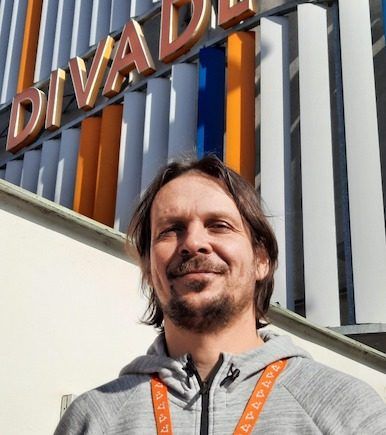観客のみなさま / Dear audience.
『開催に向けて』 アルファ劇場芸術監督ヤクブ・ホラ
東京の開かれた空間で行われる楽しい催しに、ようこそお越し下さいました。この小さなフェスティバルは、日本のプーク人形劇場とチェコのアルファ劇場の協力により生まれた長期プロジェクト「Ahoj!」から派生したものです。2021年、新宿髙島屋に隣接したオープンスペースで開催される予定だった「Ahoj!」は、コロナ禍の影響により会場を変更することを余儀なくされ、極めて限られた人数の観客にしか届けることができませんでした。ようやく今年、開かれた場所で開催されます。
ストリートアートは長い歴史を有しています。「高級」芸術や「上流」の社会階層を対象とした常設の劇場の代替として、路上を舞台にさまざまな上演芸術が生まれました。19世紀末まで、上流階級にアクセスできないアーティストたち(人形劇含む)にとっては、路上やマーケット、レストランのホールなどが生活の場であり、観客と出会う場でした。しかし20世紀後半になると、ストリートアートは別の次元を見出しました。実利的でステレオタイプな消費資本主義や、灰色で息苦しい社会主義の到来を受けて、アーティストたちは環境そのものを変えていこうとします。ニューヨークのストリートではグラフィティ・シーンが出現し、バルセロナの象徴であるランブラス通りでは多様なストリートパフォーマンスが生じ、1990年代プラハのカレル橋では自然発生的なストリートアート・フェスティバルが際限なく続いていました。優れたストリートアートは、オリジナリティ、即時性、驚き、美学、非商業主義といったいくつかの基本的な性質を備えています。そして、環境そのものを改善するという重要な効果があります。
2000年以降は、パブリック・スペースという概念の拡大も見られます。以前は公共空間といえば道路、公園、駅などでしたが、2000年以降、ショッピングセンターが世界的に重要な公共空間となりつつあります。おそらく、象徴的に言えば、中世の市場の原理が戻りつつあるのでしょう。その影響は全世代に及んでいます。商業施設は、現代の子供たちが週末に親と一緒に過ごす場所であり、ティーンエイジャーの待ち合わせ場所であり、猛暑に疲れた大人たちが涼む場所でもあります。商業施設の美的水準は、現時点ではまだ非常に低く、ステレオタイプで想像力に欠けるものです。売ることだけが目的で、それが訪れる人の心理にも影響を及ぼしています。特に、1990年代に西ヨーロッパの企業が旧社会主義国や発展途上国に建設した商業施設は、美観を極端に損なうものでした。
他方、より責任感のある企業は、商業施設においても、想像力にあふれた快適な環境を提供しようとしています。私たちのフェスティバルは、新宿高島屋と共同してこの路線を踏襲しています。今年のプログラムは、チェコのトップ人形劇団「アルファ劇場」の家族向け作品「快傑ゾロ」と、東京で最も優れた子ども向け人形劇団「人形劇団プーク」の児童向け人形劇、そしてボディペインティング・舞踏・音楽を組み合わせた興味深い即興パフォーマンスです。また昨年に引き続いて会場となる伊豆大島では、地元のシニア劇団「ホワイトモス」と大島太鼓のパフォーマンスが加わります。オンラインでは、2021年に配信したチェコ、スロベニア、イスラエル、イタリア、スペインなど欧州の優れた人形劇の映像を再配信します。
新宿と大島のストリートアートに幸あれ!
ヤクブ・ホラ(アルファ劇場)
・ ・ ・
We would like to invite you to an exciting art show that will once again bring art to the open air spaces of Tokyo. Our small festival is a continuation of the long-term project Hello Shinjuku, which was created thanks to the cooperation between the Japanese PUK Theatre and the Czech Alfa Theatre. Ahoj Shinjuku focuses on the revival of public space in the western centre of Tokyo. In 2021, the Ahoj Shinjuku festival was moved indoors due to the Covid 19 pandemic. Therefore, this year we would like to remind you of the festival program in the atrium of Department store Takashimaya.
Street art has a long history. It originated as an alternative to permanent art venues, which were intended for the “higher” art as well as the “upper” social classes. Artists who did not have access to these upper classes found their living space, as well as their audience, in the streets, marketplaces or restaurant halls. For example, European puppet theatre, which until the end of the 19th century was considered a decadent form of entertainment, also developed within street art. In the second half of the 20th century, street art found another dimension. Artists attempt to improve our environment, heavily influenced by pragmatic and stereotypical consumer capitalism, or colourless and suffocating socialism. The streets of New York have seen the emergence of a graffiti scene, culminating in, for example, the master of surprise Banksy; Barcelona’s iconic La Rambla offers a unique showcase of street styles; Prague’s Charles Bridge was the site of an endless spontaneous street art festival during the 1990s. Good street art has several basic premises: originality, immediacy, surprise, aesthetics, non-commercialism. And it has a fundamental effect: improving our environment.
After the year 2000, we also see a specific expansion of the notion of public space. Whereas in the past this was mainly understood as streets, parks or railway stations, after 2000 shopping centres are becoming an important public space worldwide. Perhaps symbolically, we are returning to the principle of medieval marketplaces. This effect affects the entire human population. We can already find groups of children in current generations spending weekends with their parents in shopping centres, teenagers using shopping centres as meeting places, and in hot areas as places to relax and cool off. The aesthetic level of shopping is still very low at the moment – stereotypical and unimaginative. The focus is mainly on selling and influencing the mindset of customers. In particular, the shopping centres built in the 1990s by Western European companies in post-socialist countries or shopping centres in developing countries are extremely aesthetically damaging.
Responsible companies, on the other hand, try to create an environment in shopping centres that can provide an imaginative and pleasant environment for a large number of people passing through. This is the line that our festival is following in collaboration with Department store Takashimaya. This year, we will offer the top Czech puppet theatre Alfa Theatre and its puppet version of the famous Mexican legend Mask of Zorro, and Tokyo’s best puppet theatre for children PUK Theatre and its charming performance for the youngest children Pukiti Chibi Umbrella Dance. We will also offer an interesting combination of bodypainting, dance and live music. Based on last year cooperation we have included to program a performance by our fellow actors on Oshima Island, White Moss, and from the same location a performance by a traditional Japanese drumming ensemble. As an added bonus, we are bringing an online version of the festival that will offer a reprise of top European puppet shows from the Czech Republic, Slovenia, Israel, Italy and Spain.
Best wishes for street art in Shinjuku and Oshima Island
Jakub Hora ( Alfa Theater )

ヤクブ・ホラ (Jakub Hora)
アルファ劇場代表取締役/UNIMAチェコセンター委員/AVIAMA役員/ASSITEJチェコ共和国員
・ ・ ・
◇新宿ストリートシアター スタッフ◇
舞台監督 / 安保 亮
進行 / 多田 純也
照明プラン / 芦辺 靖
照明OP / 川村 孝志
音響 / 須藤 祐樹
映像・撮影 / 中出 三記夫
会場美術 / デザインムジカ
広報デザイン / 鈴木壮一
事務局・制作 / 星幸恵・島村和
国際連携統括 / 山口遥子
芸術監督 / Jakub Hora(チェコ・アルファ劇場)
制作統括 / 伊井治彦(プーク人形劇場)
主催 / プーク人形劇場
| TOP | 大島 @Oshima | 出演者 performer | 配信 stream |
| 感染症対策 / infection control measures | 観客のみなさま / Dear audience | ||